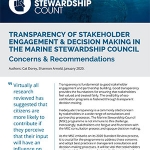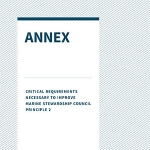Eyes on the MSC Review – Big Blue Future or Big Blue Failure?
The Marine Stewardship Council (MSC) has completed a review of its seafood certification Standard. Make Stewardship Count has watched both the process and results closely since the review began in 2018. Was the process open, inclusive and clear to everyone? Did the Fisheries Standard Review (FSR) make the critical changes needed to ensure all certified fisheries are applying global best practices? This fourth and final scorecard looks at the final contents of the new MSC Fisheries Standard and a look back on the review process.

